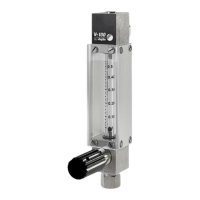Installation and commissioning
General instructions
Measuring instrument design
In addition to the type code (see appendix) we require you to supply the following information for
optimal design of the instrument:
Medium
Maximum flow rate
For design without valve: Pressure in measuring cylinder
For design with valve: Pressure before and after the control valve
Temperature
When should the control valve be mounted at the outlet?
In vacuum processes the gas expands considerably. This leads to significant measurement
errors.
The control valve should therefore always be placed at the outlet for vacuum applications.
Liquids often contain gas bubbles. These settle on the float. This results in a higher flow rate
being displayed. By installing the control valve at the outlet the gas bubbles become smaller
and are better able to flow past the float.
In the case of fluctuating back pressure (e.g. when gassing a liquid container if the level varies
markedly).
In the case of pulsating media or smaller water hammer the valve at the outlet has a cushioning
effect.
When should the control valve be mounted at the inlet?
In the case of constant after-pressure
If the control valve also has to serve as a locking valve. (e.g. if a measuring cylinder has to be
exchanged when installed).
Direct reading scale or mm-scale?
The direct reading scale (also known as the product scale) is determined for only one operating
condition.
The mm-scale is not dependent on the medium, pressure and temperature. Different tables with
various operating conditions can be used. The actual measurement value is not visible directly on
the instrument but is read using a conversion table.

